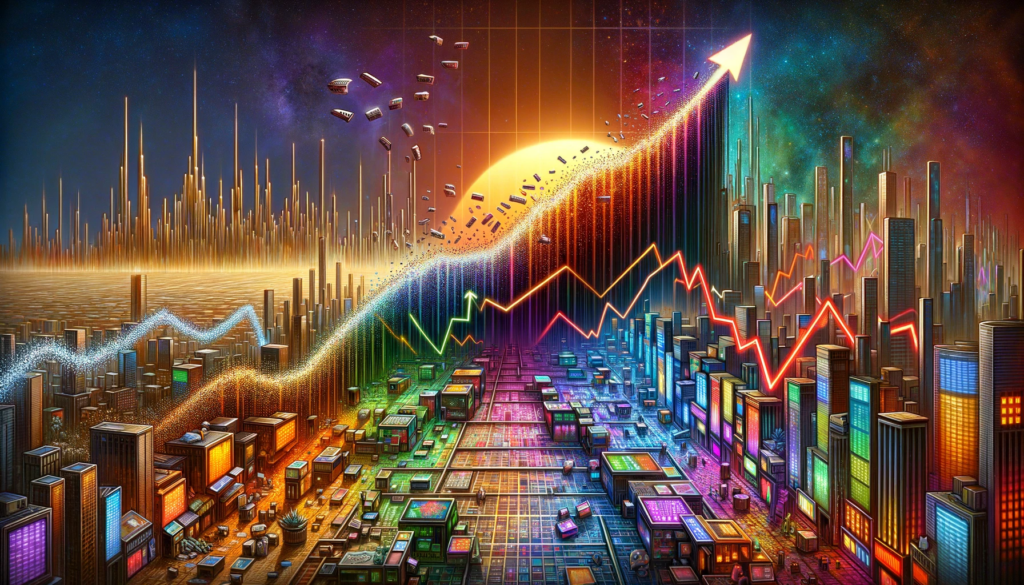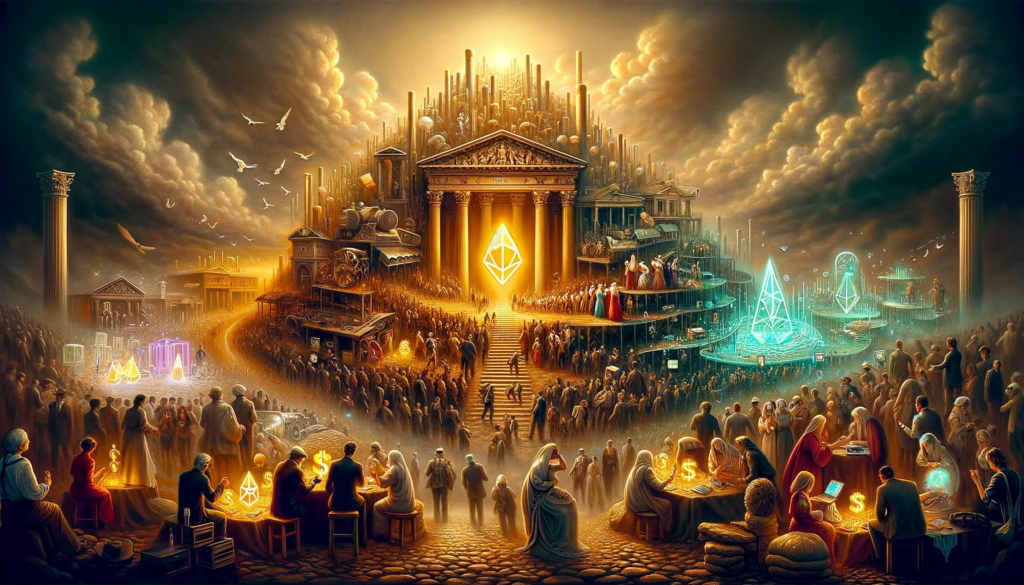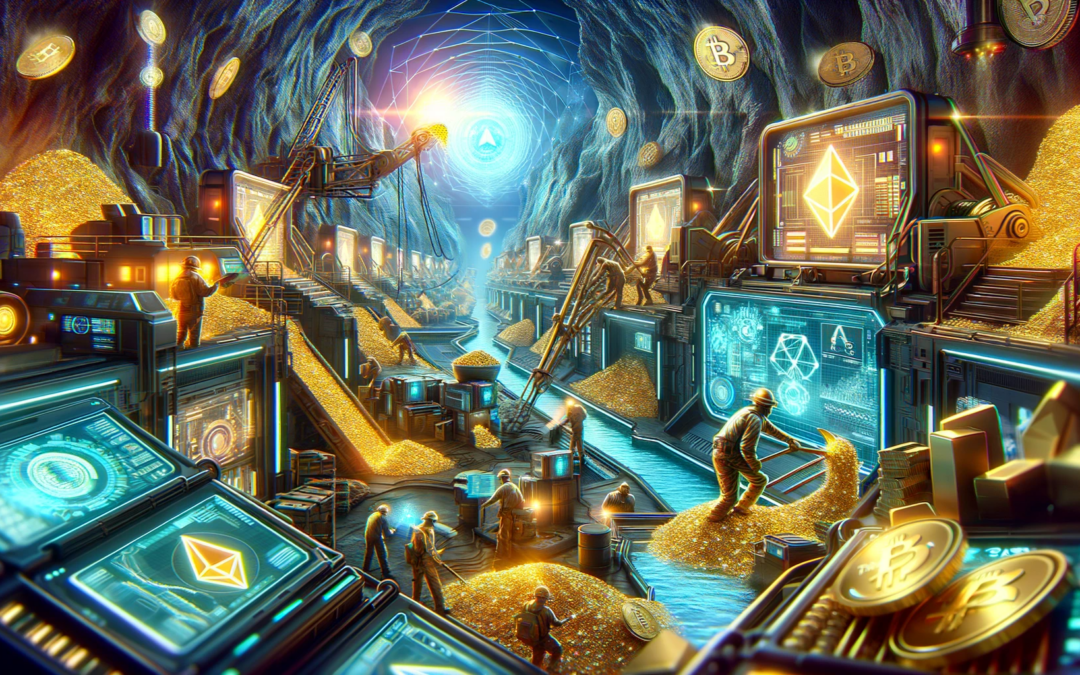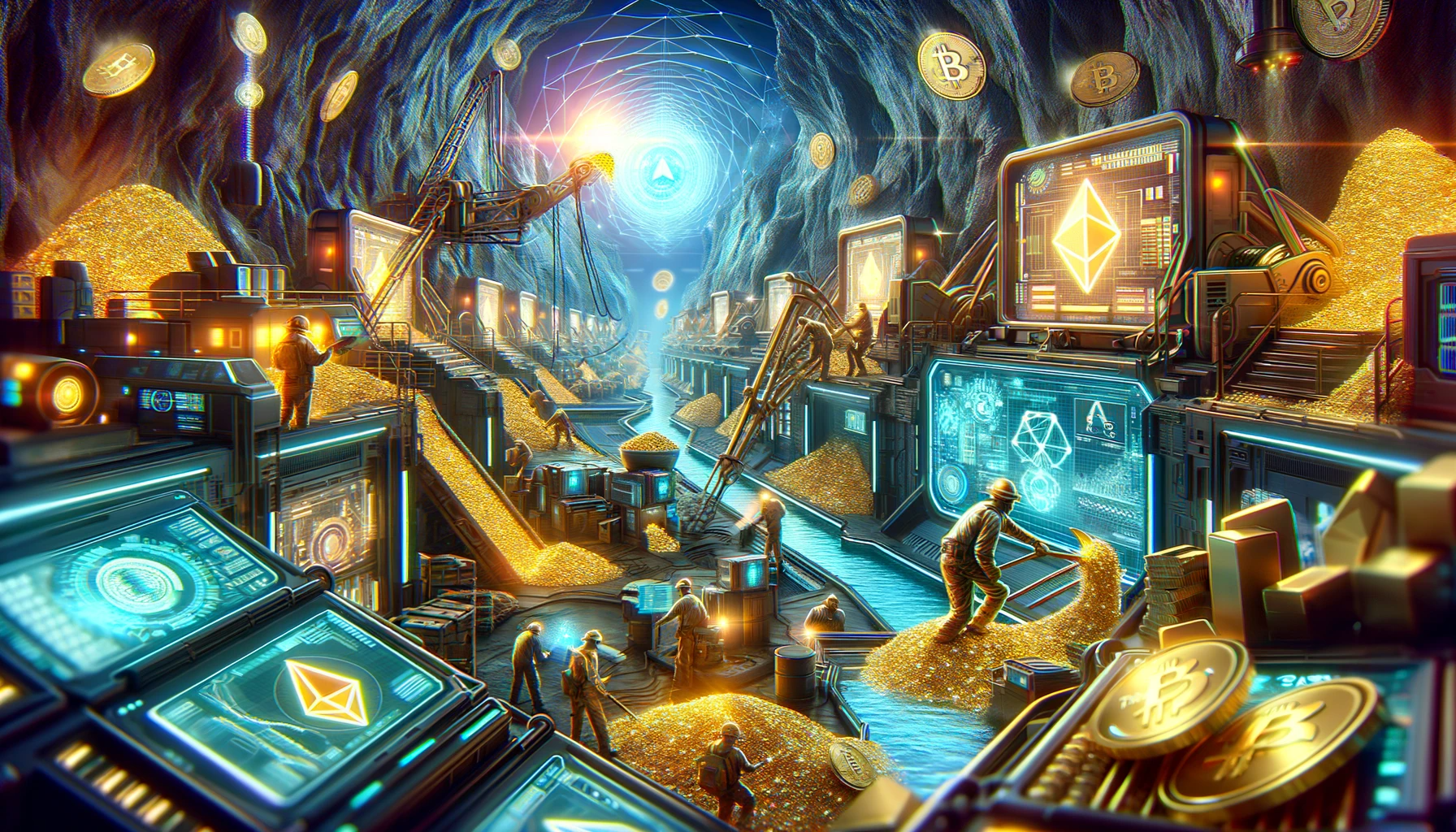NFTs: Not Just Digital Dust in the Wind Post-Market Crash
In the topsy-turvy world of digital assets, Non-Fungible Tokens (NFTs) have ridden a rollercoaster that could make even the most hardened crypto-enthusiast queasy. As we look back from our 2024 vantage point, it’s clear that NFTs have been the subject of a harsh narrative. Once hailed as the golden children of blockchain innovation during their heyday in 2021 and 2022, they’ve since been dismissed by many as nothing more than glorified JPEGs with as much value as a screen grab of a celebrity tweet.
But let’s hit pause on that cynicism jukebox for a moment. While it’s true that the market has seen better days (or rather, better years), writing off NFTs as digital tumbleweeds blowing through the wasteland of broken crypto dreams is not just premature – it’s missing the bigger picture. And what a vivid, pixel-perfect picture it is! Despite the market’s plummet, NFTs are far from being the internet’s equivalent of a garage sale bargain bin. In fact, the shift from the speculative fever of the peak years to the current climate might just be what the doctor ordered for a more mature, purpose-driven NFT ecosystem.
So, buckle up as we dive into the world of NFTs, post-market crash. We’re here to explore, with a dash of humor and a hefty dose of motivation, why NFTs are more than just a passing fad. They’re misunderstood, sure, but as we’re about to find out, there’s more to these digital darlings than meets the eye.

Section 1: “The Rise and Fall of the NFT Market”
The story of NFTs (Non-Fungible Tokens) is a classic tale of digital rags to riches, and back again. In the span of a few short years, the NFT market transformed from a niche corner of the crypto universe into a dazzling, headline-grabbing phenomenon. Let’s unpack this rollercoaster ride, paying close attention to key players like Bored Ape Yacht Club and the role of cryptocurrencies like Ethereum and Bitcoin in this saga.
2019-2020: The Early Days Initially, NFTs were quirky digital artifacts, minted and traded by a tight-knit community of blockchain enthusiasts. The concept was simple yet revolutionary: using blockchain technology, typically Ethereum, to create unique, non-interchangeable digital assets. Think of it as a digital certificate of authenticity for everything from art to tweets.
2021: The NFT Explosion Then came 2021, a year that would go down in crypto history. NFTs caught the public imagination like wildfire. Powered by Ethereum’s robust platform, which provided the necessary infrastructure for NFT creation and exchange, the market witnessed astronomical growth. Bitcoin also played a supporting role, as its surging prices fueled wider interest in all things crypto.
This was the year of headline-grabbing sales and celebrity endorsements. Collections like Bored Ape Yacht Club became the digital equivalent of luxury brands. These weren’t just images; they were status symbols, community keys, and investment assets, all rolled into one.

2022: The Peak and the Precipice In 2022, the NFT market reached dizzying heights. Prices for top-tier NFTs, like those from the Bored Ape Yacht Club, soared into the millions. However, as with many explosive trends, the peak was a prelude to a fall. The broader crypto market, including stalwarts like Bitcoin and Ethereum, began to wobble under various pressures – regulatory concerns, environmental debates, and the volatile nature of crypto itself.
2023: The Reality Check Come 2023, the market faced a harsh reality check. The once-skyrocketing value of NFTs experienced a significant downturn. High-profile NFT collections saw their values plummet as the frenzy cooled off and market sentiment shifted. The crash served as a wake-up call, highlighting the speculative nature of these digital assets and their dependence on the broader crypto market’s health.
In summary, the rise and fall of the NFT market is a story of innovation, hype, and recalibration. While Ethereum and Bitcoin laid the groundwork, it was the allure of unique, blockchain-certified ownership that propelled NFTs into the limelight. Yet, as the market cools, we’re reminded that in the world of crypto, volatility is the only constant.
Section 2: “Separating FOMO from Function: The Real Value of NFTs”
In the tumultuous world of Non-Fungible Tokens (NFTs), distinguishing between the Fear Of Missing Out (FOMO) induced price bubbles and the intrinsic value of the underlying technology is crucial. It’s easy to get lost in the headlines about overnight millionaires and seven-figure digital art sales. However, to truly understand NFTs, we need to delve into the bedrock of this phenomenon: blockchain and token technologies.
Blockchain: The Foundation of Trust At its core, blockchain is a decentralized ledger, a digital record-keeping system that’s transparent, tamper-proof, and operates without a central authority. This technology is the backbone of both NFTs and cryptocurrencies like Bitcoin and Ethereum. Blockchain’s significance lies in its ability to ensure the authenticity and uniqueness of digital assets, creating a trust framework previously unthinkable in the digital realm.
Tokens: More Than Just a Digital Asset When we talk about NFTs, we’re essentially talking about tokens. These aren’t your average tokens used for arcade games. Instead, they represent ownership of unique digital items, thanks to blockchain technology. Unlike cryptocurrencies, which are fungible and can be exchanged like-for-like, each NFT is distinct, holding its own specific information and value.
The Enduring Value of Digital Art and Assets The hype around NFTs has been predominantly driven by digital art sales. However, the concept of tokenized ownership extends far beyond just art. From real estate to intellectual property, the potential applications are vast. This tokenization confers a level of legitimacy and security to digital assets, making them more than just pixels on a screen.

The value of NFTs thus lies in their ability to redefine ownership in the digital age. They are not just a speculative investment driven by FOMO but represent a pivotal shift in how we perceive and interact with digital property.
In conclusion, the real value of NFTs isn’t in their often-volatile market price. It’s in the blockchain technology that powers them and the new world of possibilities that tokens open up. While the market hype will ebb and flow, the transformative potential of NFTs and digital assets is here to stay.
Section 3: “Emerging Applications: NFTs Beyond Digital Art”
As we venture beyond the digital art galleries of the NFT space, we uncover a realm brimming with potential applications of Non-Fungible Tokens (NFTs) across various sectors. NFTs are stepping out of their art frames and proving that they’re more than just high-priced digital collectibles. Platforms like DappGambl are at the forefront, pioneering innovative uses of NFTs that could reshape numerous industries.
NFTs in Gaming and Virtual Realities One of the most exciting frontiers for NFTs is in the gaming world. Imagine owning a unique in-game item as an NFT, which could be traded on an NFT marketplace or even used across different gaming platforms. NFTs introduce a level of ownership and transferability previously unseen in the gaming industry.
NFTs in Music and Entertainment The music industry is also tuning into the NFT trend. Artists can tokenize their music, albums, or even experiences, offering fans a new way to connect and own a piece of their favorite artist’s work. NFTs could revolutionize how intellectual property rights are managed and monetized in the entertainment sector.
Real Estate and Legal Documentation Imagine buying a house where the deed is a digital token, secured on a blockchain. NFTs could streamline property transactions, reduce fraud, and increase transparency. Similarly, legal documents like wills and contracts could be tokenized, ensuring authenticity and immutability.
NFTs in Identity Verification and Credentials NFTs have potential in identity verification, where a token represents a person’s identity or credentials. This application could be groundbreaking for sectors like education, where degrees and certifications could be issued as NFTs, making them easily verifiable and reducing the risk of fraud.
NFTs and Social Impact Platforms like DappGambl are also exploring how NFTs can be used for social impact. For example, tokenizing artwork created by underprivileged artists or using NFT sales to fund charitable causes.
In conclusion, the future of NFTs extends far beyond digital art. From gaming to legal documentation, the NFT marketplace is poised to offer innovative solutions across various sectors. As the NFT space continues to evolve, its potential applications are only limited by our imagination.

Section 4: “Learning from History: The Cautionary Tale of NFTs”
The NFT market, with its spectacular rise and subsequent crash, serves as a modern-day Icarus tale in the digital world. This section delves into the pitfalls, lessons learned, and the wider impact of the NFT crash on the crypto market and investor behavior. It’s a story marked by volatile markets and investments that, for some, proved to be less than golden.
The Bubble Bursts The NFT boom, driven by a mix of genuine innovation and speculative frenzy, created a bubble that eventually had to burst. High-profile NFTs, once sold for millions, suddenly faced the stark reality of the volatile market. The NFT crash wasn’t just a price correction; it was a reality check for investors and creators alike.
Impact on the Crypto Market The crash of the NFT market had ripples beyond its own domain, affecting the broader crypto market. Cryptocurrencies like Ethereum and Bitcoin, closely intertwined with NFT transactions, felt the tremors. This downturn served as a wake-up call to the crypto community about the inherent risks and volatility in such markets.
Investor Behavior: FOMO to Caution Initially, FOMO (fear of missing out) drove investors to pour money into what they saw as a groundbreaking opportunity. The crash shifted this mindset dramatically. The term ‘worthless investments’ began to echo in the crypto halls, as investors realized that not all that glitters in the digital world is gold. This shift marked a transition from a gold-rush mentality to a more cautious, discerning approach.

Lessons Learned The NFT crash taught several key lessons:
- Diversification is Key: Don’t put all your eggs in one digital basket.
- Due Diligence Matters: Understand what you’re investing in.
- Long-term Perspective: Look beyond immediate gains to the potential lasting value of assets.
The NFT crash, while painful for many, offered valuable insights into the nature of digital investments. It’s a reminder that the digital market is as real as any other, with all the risks and rewards that come with it.
Conclusion
As we reach the end of our exploration into the world of Non-Fungible Tokens (NFTs), it’s crucial to distinguish between the ephemeral hype and the long-term potential of NFT technology. Our journey through the rise and fall of the NFT market, the real value behind the technology, its emerging applications, and the cautionary tales of the crash, brings us to a crucial realization: NFTs are much more than just a fleeting trend in the digital universe.
Beyond the Hype The hype surrounding NFTs, characterized by sensational headlines and speculative investments, was indeed a rollercoaster of digital dreams and disappointments. But beneath this facade lies a technological innovation with profound implications. Blockchain technology, the bedrock of NFTs, offers a new way to conceive of ownership and authenticity in the digital world. This is the enduring value that outlives market fluctuations.
Embracing Technological Innovation As with any emerging technology, the path of NFTs is not without its bumps and bends. The journey, however, is as important as the destination. The lessons learned from the market’s volatility and the innovative applications of NFTs in various sectors show us that embracing technological innovation is not just about chasing the next big thing; it’s about understanding its potential to reshape our world.
A Call to Optimism and Action As we look towards the future, let’s approach NFTs and similar innovations not with blind optimism but with informed enthusiasm. This means understanding the technology, recognizing its potential, and being cautious of its pitfalls. It’s about being part of a conversation that’s shaping the future of digital ownership, art, and beyond.
Clearly, the story of NFTs is far from over. It’s a narrative still being written, full of potential and promise. So, let’s keep our eyes wide open to the possibilities, our minds curious about the advancements, and our spirits undeterred by the challenges. The digital frontier is vast, and NFTs are just one exciting part of this ever-evolving landscape.
TL;DR Summary:
This exploration into the world of Non-Fungible Tokens (NFTs) reveals that they are much more than a fleeting trend, despite the recent market crash. We’ve looked at the rise and fall of the NFT market, distinguishing the short-lived hype from the lasting potential of NFT technology. The post highlights the various applications of NFTs extending beyond digital art, such as in gaming, music, and real estate, and underscores the lessons learned from the market’s volatility. It emphasizes that the true value of NFTs lies in the innovative blockchain technology that underpins them. Ultimately, the journey of NFTs is a testament to the importance of understanding and embracing technological innovation in the digital age.


